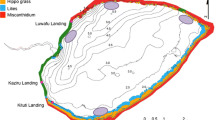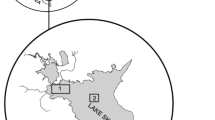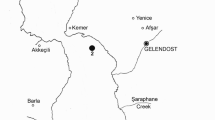Abstract
We aimed to study whether the varying changes in predation pressure by perch (Perca fluviatilis) reflect the biomass, density, and community structure of the benthic macroinvertebrates. Prey preference is size-dependent, and overall predation pressure is density dependent, and thus the size structure of the P. fluviatilis population should affect the structure of the macroinvertebrate community, and the population density of P. fluviatilis should reflect the overall density of benthic macroinvertebrates. We sampled the littoral benthic community in a boreal lake that had been divided into two parts that were subjected to two different fishing procedures during 2007–2012 period and analyzed the macroinvertebrate diet of fish. The benthic macroinvertebrate community reflected the predation pressure. Total macroinvertebrate biomass increased during the study period in the lake division with a non-size-selective fishing procedure (NSF), i.e., all invertivorous perch size-classes targeted, but decreased in the section with negatively size-selective fishing procedure (SSF), i.e., large invertivorous individuals ≥ 16 cm were not targeted. This difference was a result of the increase in large-sized species, such as Odonata, for the NSF procedure and decrease in the SSF procedure. In contrast to total biomass, total macroinvertebrate density did not show a response to predator size structure but rather total macroinvertebrate density decreased with increasing fish density. The study demonstrates the effect of predation pressure of P. fluviatilis on benthic communities, thus highlighting the keystone predator role of the species in boreal lakes and gives more insight on the multiple effects of fish predation on littoral benthic communities.




Similar content being viewed by others
References
Anderson MJ (2001) A new method for non-parametric multivariate analysis of variance. Austral Ecol 26:32–46
Blumenshine CB, Lodge D, Hodgson JR (2000) Gradient of fish predation alters body size distributions of lake benthos. Ecology 81:374–386
Bonneau JL, Scarnecchia DL (2015) Response of benthic macroinvertebrates to carp (Cyprinus carpio), biomanipulation in three tributaries of a eutrophic, great plains reservoir USA. Trans Kansas Acad Sci 118:13–26
Brönmark C (1994) Effects of tench and perch on interactions in a freshwater, benthic food chain. Ecology 75:1818–1828
CEN (2005) Water quality—sampling fish with multi-mesh gillnets. European Standard EN 14757:2005
Cobb SE, Watzin MC (1998) Trophic interactions between yellow perch (Perca flavescens) and their benthic prey in a littoral zone community. Can J Fish Aquat Sci 55:28–36
Corbet PS (1980) Biology of Odonata. Ann Rev Entomol 25:189–217
Covich AP, Palmer MA, Crowl TA (1999) The role of benthic invertebrate species in freshwater ecosystems: zoobenthic species influence energy flows and nutrient cycling. Bioscience 49:119–127
Crowder LB, Cooper WE (1982) Habitat structural complexity and the interaction between bluegills and their prey. Ecology 63:1802–1813
Diehl S (1992) Fish predation and benthic community structure: the role of omnivory and habitat complexity. Ecology 73:1646–1661
Englund G (2005) Scale dependent effects of predatory fish on stream benthos. Oikos 111:19–30
Estlander S (2011) Fishes of darkness. Water colour-regulated competitive interactions in humic lakes. Ph.D. thesis. Department of Environmental Sciences. University of Helsinki
Estlander S, Nurminen L, Olin M, Vinni M, Horppila J (2009) Seasonal fluctuations in macrophyte cover and water transparency of four brown-water lakes: implications for crustacean zooplankton in littoral and pelagic habitats. Hydrobiologia 620:109–120
Estlander S, Nurminen L, Olin M, Vinni S, Immonen S, Rask M, Ruuhijärvi J, Horppila J, Lehtonen H (2010) Diet shifts and food selection of perch (Perca fluviatilis) and roach (Rutilus rutilus) in humic lakes of varying water colour. J Fish Biol 77:241–256
Estlander S, Horppila J, Olin M, Vinni M, Lehtonen H, Rask M, Nurminen L (2012) Troubled by the humics—effects of water colour and interspecific competition on the feeding efficiency of planktivorous perch. Boreal Environ Res 17:305–312
Estlander S, Horppila J, Olin M, Nurminen L, Rask M, Lehtonen H (2017) Zooplankton rhapsody: community counteracts enhanced fish predation by increasing species diversity. Boreal Environ Res 22:157–167
Gilinsky E (1984) The role of fish predation and spatial heterogeneity in determining benthic community structure. Ecology 65:455–468
Gower JC (1966) Some distance properties of latent root and vector methods used in multivariate analysis. Biometrika 53:325–328
Grönroos M (2009) Pohjaeläimet pienessä kirkkaassa metsäjärvessä ja tehokkaan kalastuksen vaikutus yhteisörakenteeseen. MSc-thesis. Department. of Environmental Sciences. University of Helsinki. pp 52
Hanson JM (1990) Macroinvertebrate size-distributions of two contrasting freshwater macrophyte communities. Freshw Biol 24:481–491
Hanson JM, Leggett WC (1986) Effect of competition between two freshwater fishes on prey consumption and abundance. Can J Fish Aquat Sci 43:1363–1372
Hershey AE (1985) Effects of predatory sculpin on the chironomid communities in an arctic lake. Ecology 66:1131–1138
Jones RI, Arvola L (1984) Light penetration and some related characteristics in small forest lakes in Southern Finland. Verh Int Ver Theor Angew Limnol 22:811–816
Karlsson J, Byström P, Ask J, Persson L, Jansson M (2009) Light limitation of nutrient-poor ecosystems. Nature 460:506–509
Keast A (1977) Diet overlaps and feeding relationships between the year classes in the yellow perch (Perca flavescens). Environ Biol Fishes 2:53–70
Kornijów R, Measey GM, Moss B (2016) The structure of the littoral: effects of waterlily density and perch predation on sediment and plant-associated macroinvertebrate communities. Freshw Biol 61:32–50
Leppä M, Hämäläinen H, Karjalainen J (2003) The response of benthic macroinvertebrates to whole-lake biomanipulation. Hydrobiologia 498:97–105
Mittelbach GG (1988) Competition among refuging sunfishes and effects of fish density on littoral zone invertebrates. Ecology 69:83–98
Morin PJ (1984) The impact of fish exclusion on the abundance and species composition of larval odonates: results of short-term experiments in a North Carolina farm pond. Ecology 65:53–60
Nilsson AN (ed) (1996) Aquatic insects of North Europe—a taxonomic handbook. Apollo Books Aps, Stenstrup
Nilsson AN (ed) (1997) Aquatic insects of North Europe—a taxonomic handbook. Apollo Books Aps, Stenstrup
Nilsson E, Hertonsson P, Stenberg M, Brodersen J, Olsson K, Stenroth P et al (2006) Facilitation and interference among three predators affect their consumption of a stream-dwelling mayfly. Freshw Biol 51:1507–1514
Nummi P, Väänänen V-M, Rask M, Nyberg K, Taskinen K (2012) Competitive effects of fish in a structurally simple habitat: perch, invertebrates, and goldeneye in small boreal lakes. Aquat Sci 74:343–350
Oksanen J, Blanchet FG, Friendly M, Kindt R, Legendre P, McGlinn D, Minchin PR, O’Hara RB, Simpson GL, Solymos P, Stevens MHH, Szoecs E, Wagner H (2017) vegan: community ecology package. R package version 2.4-3. https://CRAN.R-project.org/package=vegan
Olin M, Vinni M, Lehtonen H, Rask M, Ruuhijärvi J, Saulamo K (2010) Environmental factors regulate the effects of roach Rutilus rutilus and pike Esox lucius on perch Perca fluviatilis populations in small boreal forest lakes. J Fish Biol 76:1277–1293
Olin M, Rask M, Tammi J (2013) Development and evaluation of the Finnish fish-based lake classification method. Hydrobiologia 713:149–166
Olin M, Tiainen J, Rask M, Vinni M, Nyberg K, Lehtonen H (2017) Effects of non-selective and size-selective fishing on perch populations in a small lake. Boreal Environ Res 22:137–155
Petersen JE, Englund G (2005) Dimensional approaches to designing better experimental ecosystems: a practitioners guide with examples. Oecologia 145:216–224
Pierce C, Hinrichs BD (1997) Response of littoral invertebrates to reduction of fish density: simultaneous experiments in ponds with different fish assemblages. Freshw Biol 37:397–408
Pope KL, Hannelly EC (2013) Response of benthic macroinvertebrates to whole-lake, non-native fish treatments in mid-elevation lakes of the Trinity Alps, California. Hydrobiologia 714:201–215
Power ME, Tilman D, Estes JA, Menge BA, Bond WJ, Mills LS, Daily G, Castilla JC, Lubchenco J, Paine RT (1996) Challenges in the quest for keystones. Bioscience 46:609–620
Pyke HP (1984) Optimal foraging theory: a critical review. Ann Rev Ecol Syst 15:523–575
Rask M (1986) The diet and diel feeding activity of perch, Perca fluviatilis L., in a small lake in southern Finland. Ann Zool Fennici 23:49–56
Rask M, Hiisivuori C (1985) The predation on Asellus aquaticus (L.) by perch, Perca fluviatilis L., in a small forest lake. Hydrobiologia 121:27–33
Rask M, Järvinen M, Kuoppamäki K, Pöysä H (1996) Limnological responses to the collapse of the perch population in a small lake. Ann Zool Fennici 33:517–524
Rask M, Viljanen M, Sarvala J (1999) Humic lakes as fish habitats. In: Keskitalo J, Eloranta P (eds) Limnology of humic waters. Backhuys Publishers, Leiden, pp 209–224
Rask M, Appelberg M, Hesthagen T, Tammi J, Beier U, Lappalainen A (2000) Fish status survey of Nordic lakes—species composition, distribution, effects of environmental change. TemaNord 508:1–58
Rask M, Pöysä H, Nummi P, Karppinen C (2001) Recovery of the perch (Perca fluviatilis) in an acidified lake and subsequent responses in macroinvertebrates and the goldeneye (Bucephala clangula). Water Air Soil Pollut 130:1367–1372
R Core Team (2017) R: a language and environment for statistical computing. R foundation for statistical computing. Vienna, Austria. URL https://www.R-project.org/
Rice JA, Crowder LB, Rose KA (1993) Interactions between size-structured predator and prey populations: experimental test and model comparison. Trans Am Fish Soc 122:481–491
Ringler NH (1979) Prey selection by benthic feeders. In: Stroud R, Clepper H (eds) Predator-prey systems in fishery management. Sport Fishing Institute, Washington, pp 219–229
Schindler DW (1987) Detecting ecosystem response to anthropogenic stress. Can J Fish Aquat Sci 44:6–25
Schindler DW (1998) Replication versus realism: the need for ecosystem-scale experiments. Ecosystems 1:323–334
Seber GAF (1982) The estimation of animal abundance and related parameters, 2nd edn. Edward Arnold, London
Stenson JAE (1979) Predator-prey relations between fish and invertebrate prey in some forest lakes. Ins Freshw Res Drottningholm Rep 58:166–183
Strayer DL (1991) Perspectives on the size structure of lacustrine zoobenthos, its causes, and its consequences. J N Am Benthol Soc 10:210–221
Tarvainen M, Anttalainen A, Helminen H, Keskinen T, Sarvala J, Vaahto I, Karjalainen J (2008) A validated bioenergetics model for ruffe Gymnocephalus cernuus and its applications to a northern lake. J Fish Biol 73:536–556
Thorpe JH, Bergey EA (1981) Field experiments on responses of a freshwater, benthic macroinvertebrate community to vertebrate predators. Ecology 62:365–375
Vance-Chalcraft HD, Soluk DA (2005) Multiple predator effects result in risk reduction for prey across multiple prey densities. Oecologia 144:472–480
Venturelli PA, Tonn WM (2005) Invertivory by northern pike (Esox lucius) structures communities of littoral macroinvertebrates in small boreal lakes. J N Am Benthol Soc 24:904–918
Wallace ID, Wallace B, Philipson GN (1990) A key to the case-bearing caddis larvae of Britain and Ireland. Scientific publication no. 51, Freshwater Biological Association, Ambleside
Ware DM (1972) Predation by rainbow trout (Salmo gairdneri): the influence of hunger, prey density and prey size. J Fish Res Board Can 29:1193–1201
Windell JT (1971) Food analysis and the rate of digestion. In: Ricker W (ed) Methods for assessment of fish production in fresh waters. Blackwell Scientific Publications, Oxford, pp 215–226
Acknowledgements
We thank Evo Fisheries Research Station for providing excellent facilities and all the helping hands in the field during the years of this study. The study was funded by Bergsrådet Bror Serlachius and the Three-year Research Grants of University of Helsinki.
Author information
Authors and Affiliations
Corresponding author
Additional information
Handling Editor: Piet Spaak
Rights and permissions
About this article
Cite this article
Nurminen, L., Hellén, N., Olin, M. et al. Fishing-induced changes in predation pressure by perch (Perca fluviatilis) regulate littoral benthic macroinvertebrate biomass, density, and community structure. Aquat Ecol 52, 1–16 (2018). https://doi.org/10.1007/s10452-017-9641-4
Received:
Accepted:
Published:
Issue Date:
DOI: https://doi.org/10.1007/s10452-017-9641-4




